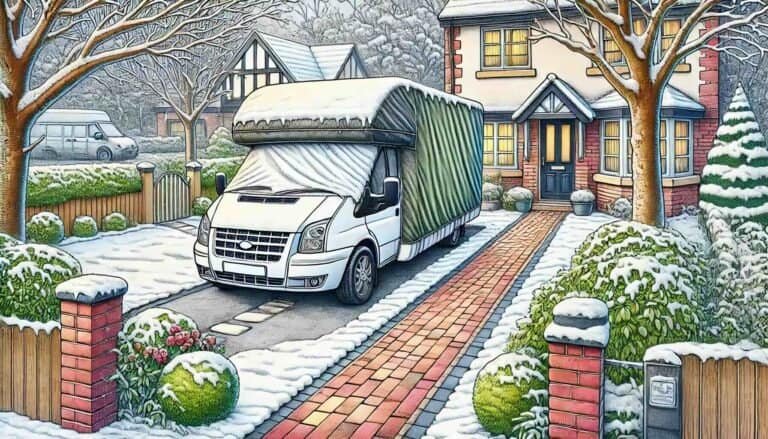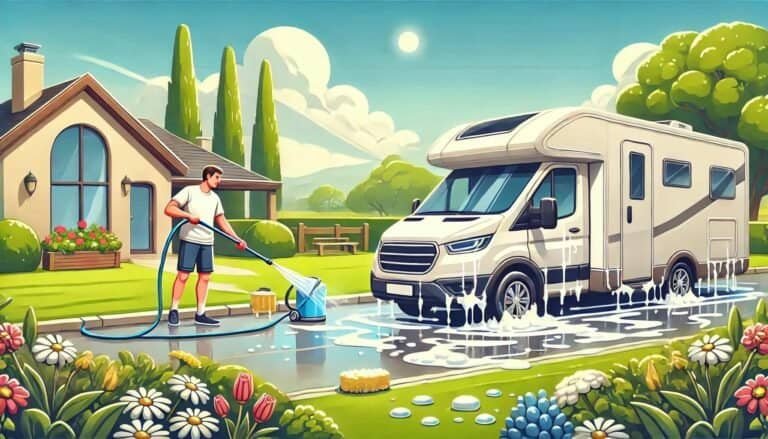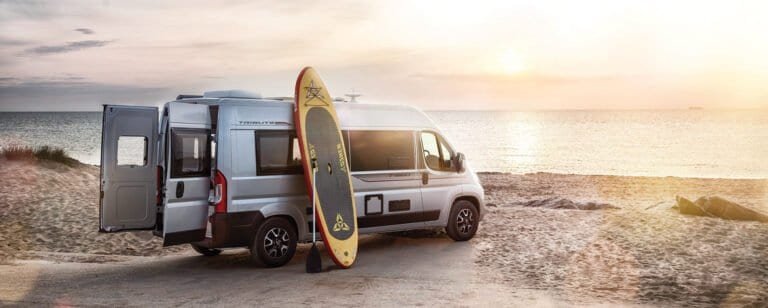Regular maintenance is essential for keeping campervans and motorhomes in excellent shape and ensuring safe, enjoyable journeys. Learning a few basic DIY maintenance tips can help you avoid costly repairs, maintain efficiency, and address minor issues before they escalate. This guide covers simple yet effective maintenance tasks to keep your campervan or motorhome in top condition, all achievable without professional assistance.
Key Takeaways
- Choose a vehicle that matches your needs, budget, and lifestyle.
- Plan your routes and overnight stops with the help of maps and apps like Campercontact and park4night.
- Set a realistic budget and track expenses, focusing on ways to save while on the road.
- Follow essential safety practices for both driving and parking.
- Establish routines and organise your space for a comfortable, functional living area.
1. Basic Routine Checks to Perform Before Every Trip
Before setting out on any journey, a quick round of pre-trip checks can make a significant difference in the reliability of your vehicle. These checks help identify potential issues and improve safety on the road, especially for longer trips.
Checklist for Pre-Trip Inspections
- Tyre Pressure and Tread: Properly inflated tyres improve fuel efficiency and handling. Use a pressure gauge to check the pressure on each tyre, including the spare, and adjust according to the manufacturer’s recommendations. Inspect the tread for wear and replace tyres if they’re nearing the minimum tread depth (typically 1.6mm in Europe).
- Fluid Levels: Check engine oil, coolant, brake fluid, and windshield washer fluid levels. Low levels can indicate leaks, so top off and check for any visible drips or pooling under the vehicle.
- Lights and Indicators: Ensure all headlights, brake lights, indicators, and interior lights are functioning correctly. Replace any bulbs that are dimming or burnt out, as faulty lights can pose a safety risk and may be illegal in some countries.
- Battery Health: Test the main vehicle battery and the leisure battery if you have one. Batteries should hold a charge well; if they seem weak, recharge or replace them as necessary.
- Exterior Walkaround: Do a quick exterior check for any visible signs of damage, such as cracks in windows, loose panels, or wear on mirrors. These minor issues can become bigger problems if ignored.
- Brakes and Steering Response: Before hitting the road, press on the brakes and turn the steering wheel to ensure they respond smoothly. Any squeaking, grinding, or delay in response could indicate a problem that requires professional inspection.
2. Essential Tools for Campervan and Motorhome Maintenance
Having a basic set of tools on board is crucial for handling minor repairs and maintenance tasks on the go. Here’s a list of recommended tools and storage solutions to keep your toolkit organised yet compact.
Recommended Toolkit Essentials
- Tyre Pressure Gauge and Inflator: A reliable tyre pressure gauge and a portable inflator allow you to check and adjust tyre pressure anytime, helping to avoid unnecessary stops and keep tyres in optimal condition.
- Socket and Screwdriver Set: A small set with multiple sizes covers a range of uses, from tightening loose screws on cabinetry to handling minor engine maintenance tasks.
- Multimeter: Handy for testing electrical connections and troubleshooting battery or power issues.
- Basic Wrench Set: An adjustable wrench or a small set of wrenches can handle various bolts and connections commonly found in campervans and motorhomes.
- Duct Tape and Cable Ties: These are essential for quick, temporary fixes, such as securing loose wires or sealing small leaks until you can reach a repair centre.
- Cleaning Supplies: A compact set of cleaning supplies, like microfibre cloths, surface wipes, and a small vacuum, will help you keep the interior clean and comfortable.
Storage Solutions for Tools
Staying organised is key, especially in a compact space. Consider storing your tools in a foldable organiser, which can be tucked away when not in use. Magnetic strips or hanging organisers can also help keep tools in easy reach without taking up valuable floor space. When possible, store heavier tools in lower compartments to maintain stability while driving.
3. Tyre Care and Maintenance
Tyre care is essential for the safety and efficiency of any vehicle, especially campervans and motorhomes that carry heavier loads. Properly maintained tyres improve fuel efficiency, reduce the risk of breakdowns, and ensure better handling on the road.
Key Tyre Maintenance Tips
- Check Tyre Pressure Regularly: Tyres should be inflated to the recommended pressure levels provided by the manufacturer. For accurate readings, check pressure when tyres are cold and adjust as needed. Underinflated or overinflated tyres wear unevenly and can cause safety issues.
- Inspect for Tread Wear and Damage: Tyres with insufficient tread depth (under 1.6mm in Europe) reduce grip, especially in wet conditions. Look for signs of wear and check for cracks, punctures, or uneven tread patterns, which may indicate alignment issues or overloading. Replace tyres that are worn or damaged.
- Rotate Tyres for Even Wear: Rotating your tyres every 8,000–10,000 km helps to distribute wear more evenly across all tyres. This process can prolong tyre life and improve handling.
- Be Prepared for Flats: Carry a spare tyre, a jack, and a tyre iron or lug wrench. Familiarise yourself with the process of changing a tyre so you’re ready to handle a flat if it occurs. If you prefer, keep a tyre repair kit on hand for temporary fixes.
Pro Tip: Some campervan and motorhome owners opt for all-terrain tyres if they frequently travel on rougher roads. These tyres provide added durability, but they may be noisier and less efficient on paved roads, so consider your usual travel terrain before switching.
4. Battery Maintenance and Troubleshooting
Motorhomes and campervans usually have two types of batteries: the main vehicle battery and a leisure battery that powers appliances and lighting when parked. Proper battery maintenance ensures that your vehicle starts smoothly and your amenities remain functional on the road.
Maintaining Your Vehicle and Leisure Batteries
- Regularly Test Battery Charge Levels: For both types of batteries, check the charge level regularly, especially if you’re not using the vehicle daily. A multimeter or a battery monitor can give you a quick reading of your battery’s charge.
- Keep Battery Terminals Clean: Corrosion on battery terminals is common, especially if batteries are exposed to moisture. Check for any build-up on the terminals, and clean them gently using a brush and a solution of baking soda and water. This will ensure a stronger, uninterrupted connection.
- Recharge Batteries as Needed: Most campervan owners use solar panels or a generator to recharge their leisure batteries while parked. The vehicle battery recharges while driving, but if you’re stationary for an extended period, consider using a portable battery charger to avoid a dead battery.
- Monitor Battery Health: Batteries don’t last forever. The vehicle battery usually lasts between 3-5 years, and leisure batteries typically last 2-3 years with regular use. If you notice frequent issues with battery charge, it may be time to replace it.
Troubleshooting Common Battery Issues
- Battery Draining Quickly: If your leisure battery drains faster than usual, check for any devices or appliances that might be drawing power even when they’re turned off. Consider unplugging items when not in use, and install LED lights to reduce power usage.
- Slow or Weak Engine Start: This issue is often a sign of a weak vehicle battery. Try recharging the battery, but if it still struggles, it may be due for replacement.
- Battery Not Charging Properly: Check the charging connections and inspect any solar panels or chargers you use. Loose or corroded connections can prevent effective charging.
Pro Tip: To extend battery life, avoid letting your batteries drain fully before recharging. Keeping them topped off when possible will help prolong their lifespan and ensure they’re ready to go when you need them.
5. Maintaining the Water and Plumbing System
A functioning water system is essential for campervan or motorhome living, providing water for drinking, cooking, and cleaning. Regular maintenance of the water and plumbing system ensures that it remains hygienic and operates smoothly.
Key Tips for Water System Maintenance
- Check for Leaks: Inspect the pipes, hoses, and fittings for any signs of leaks, particularly after long drives. Even small leaks can lead to bigger issues over time, including water damage or mould growth. If you spot any signs of water, tighten fittings or replace worn hoses as needed.
- Sanitise the Water Tank Regularly: Over time, bacteria and algae can grow in the water tank. To keep water safe and fresh, sanitise the tank every few months. Simply add a small amount of bleach or a specialised tank cleaner to a full tank, let it sit for a few hours, then rinse thoroughly to remove any cleaning residue.
- Flush the System Periodically: Flushing your water system helps remove any build-up that may affect taste or flow. To flush, simply run fresh water through the system, including taps and shower heads, until the water runs clear. This process is particularly useful after long periods of storage.
- Winterise the Plumbing System: If you’re storing your vehicle in winter or travelling through freezing conditions, it’s important to winterise the plumbing system to prevent pipes from freezing and bursting. Drain all water tanks, pipes, and taps, and consider using non-toxic antifreeze designed for RVs in any remaining water lines.
Pro Tip for Preventing Odours
Occasionally pour a mixture of baking soda and vinegar down the drains to keep them fresh and odour-free. This natural solution helps prevent any unwanted smells in your compact living space.
6. Keeping Your Campervan or Motorhome Interior Fresh
Maintaining a clean and fresh interior is essential for a comfortable and enjoyable travel experience. Campervans and motorhomes are prone to dirt and dust, especially when travelling on rough roads or parking in nature, so regular upkeep is key.
Cleaning and Organising Tips
- Vacuum and Dust Regularly: Dust and crumbs can build up quickly in small spaces. A portable vacuum is helpful for keeping the floor, seats, and small corners clean. Wipe down surfaces regularly with a microfibre cloth to keep dust at bay.
- Maintain Upholstery and Bedding: Upholstery, pillows, and bedding can absorb odours and dust. Freshen them up regularly by shaking them out or using a fabric spray. For a deeper clean, removable covers can be washed periodically.
- Keep Mould and Mildew at Bay: Condensation and humidity can lead to mould, especially in the colder months. Use a dehumidifier or ventilation fan to reduce moisture, and wipe down any areas that may trap water. Be vigilant about drying wet items and airing out the interior on warmer days.
- Control Food Odours: When cooking inside your campervan or motorhome, food smells can linger. Ventilate the space by opening windows and using a fan while cooking. A small air purifier can also help keep the air fresh.
Preventing and Tackling Odours
- Natural Odour Absorbers: Place natural odour absorbers like baking soda, coffee grounds, or activated charcoal around the van to absorb unwanted smells. These are especially useful in the fridge, cupboards, and near the waste bin.
- Routine Waste Disposal: Dispose of rubbish frequently to avoid smells building up, especially in warmer weather. Use sealed waste bags to minimise odours between stops.
Maintenance Checklist for Regular and Seasonal Tasks
Keeping track of routine maintenance tasks is essential for ensuring your campervan or motorhome stays in good shape. The following table outlines recommended maintenance tasks and their suggested frequency.
| Task | Frequency | Notes |
|---|---|---|
| Check tyre pressure and tread | Every trip | Ensure tyres are properly inflated and inspect for wear or damage. |
| Top up fluid levels (engine oil, coolant, brake fluid, etc.) | Before long trips | Essential for vehicle safety and engine performance. |
| Inspect battery terminals for corrosion | Monthly | Clean battery terminals to prevent corrosion and ensure proper connection. |
| Clean and sanitise water tank | Every 3–6 months | Prevent bacteria build-up and ensure clean drinking water. |
| Check for leaks in plumbing system | Every 6 months | Look for leaks in hoses, pipes, and fittings to prevent water damage. |
| Rotate tyres | Every 8,000–10,000 km | Evenly distribute wear across all tyres for longer life. |
| Flush water system | Every 6 months | Keep water lines clear and free of build-up. |
| Check and clean air filters | Every 6 months | Maintain air quality and engine efficiency. |
| Winterise plumbing system | Before cold weather | Drain water tanks and pipes to prevent freezing and damage. |
| Interior cleaning (upholstery, floors, etc.) | Weekly or as needed | Keep the living space fresh, especially in high-traffic areas like the kitchen and seating areas. |
| Check for mould and condensation | Monthly | Keep interior moisture levels in check and clean any affected areas promptly. |
Conclusion
Regular DIY maintenance is crucial for keeping your campervan or motorhome in peak condition, ensuring safety, efficiency, and comfort on your travels. From checking tyres and batteries to maintaining the water system, these simple tasks can prevent costly repairs and keep your vehicle road-ready. With the tips and guidance in this article, you’ll be well-equipped to tackle basic maintenance on your own and enjoy a smooth, worry-free journey on the open road.
Frequently Asked Questions (FAQs)
1. How often should I change the oil in my campervan or motorhome?
Oil should generally be changed every 5,000–10,000 km, or as per the vehicle manufacturer’s guidelines. Regular oil changes help maintain engine performance and extend the life of the engine.
2. What tools should I always keep in my campervan for maintenance?
A basic toolkit should include a tyre pressure gauge, wrench set, screwdrivers, a multimeter, duct tape, and a portable vacuum. These tools will cover most small DIY repairs and maintenance tasks.
3. How do I clean and maintain my campervan’s water tank?
To clean your water tank, empty it and then sanitise it with a diluted bleach solution. Let the solution sit for a few hours, then rinse thoroughly. Doing this every 3–6 months will keep the tank free from bacteria.
4. How can I prevent mould in my campervan?
Mould thrives in damp environments. To prevent it, ensure proper ventilation, especially in the kitchen and bathroom areas. Use a dehumidifier or leave windows slightly open when possible to maintain airflow, and regularly check for signs of dampness.
5. How do I winterise my campervan or motorhome?
Winterising involves draining the water system, emptying the water tanks, and using non-toxic antifreeze to protect the plumbing from freezing. Store the vehicle in a dry, frost-free location, and cover it to protect from the elements.
6. How do I know if my tyres need to be replaced?
If the tread depth is less than 1.6mm or if you notice cracks, bulges, or punctures, it’s time to replace the tyres. Regularly check the tyres for wear, especially if you travel on rough or unpaved roads.
7. Can I maintain my campervan or motorhome on my own, or should I always go to a mechanic?
Many basic maintenance tasks can be done yourself, such as checking tyre pressure, topping up fluids, and cleaning the water system. However, for complex issues like engine repairs or electrical faults, it’s best to consult a professional.
8. How often should I rotate my campervan tyres?
Tyre rotation should be done every 8,000–10,000 km to ensure even wear. This is particularly important for larger vehicles, such as motorhomes, to maintain handling and prolong tyre life.
9. What’s the best way to store a campervan during the off-season?
Clean the interior thoroughly, drain the water system, and disconnect the batteries before storing the vehicle. If possible, store it in a dry, sheltered place to protect the exterior and interior from weather damage.
10. Do I need special insurance for DIY maintenance?
Most motorhome and campervan insurance policies will cover DIY maintenance as long as you aren’t making major alterations to the vehicle. However, always check your policy and consult with your insurance provider to ensure you’re covered for specific DIY repairs.







